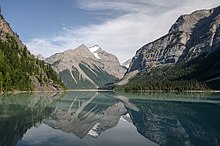Surface water

Surface water is
The vast majority of surface water is produced by
There are three major types of surface water. Permanent (perennial) surface waters are present year round, and includes
Measurement

Surface water can be measured as annual runoff. This includes the amount of rain and snowmelt drainage left after the uptake of nature, evaporation from land, and transpiration from vegetation. In areas such as California, the California Water Science Center records the flow of surface water and annual runoff by utilizing a network of approximately 500 stream gages collecting real time data from all across the state. This then contributes to the 8,000 stream gage stations that are overseen by the USGS national stream gage record. This in turn has provided to date records and documents of water data over the years. Management teams that oversee the distribution of water are then able to make decisions of adequate water supply to sectors. These include municipal, industrial, agricultural, renewable energy (hydropower), and storage in reservoirs.[5]
Impacts of climate change
Due to
This number will continue to increase as global warming persists.Climate change has a direct connection with the water cycle. It has increased evaporation yet decreased precipitation, runoff, groundwater, and soil moisture. This has altered surface water levels. Climate change also enhances the existing challenges we face in water quality. The quality of surface water is based on the chemical inputs from the surrounding elements such as the air and the nearby landscape. When these elements are polluted due to human activity, it alters the chemistry of the water.[7]
Conjunctive use of ground and surface water
Surface and groundwater are two separate entities, so they must be regarded as such. However, there is an ever-increasing need for management of the two as they are part of an interrelated system that is paramount when the demand for water exceeds the available supply (Fetter 464). Depletion of surface and ground water sources for public consumption (including industrial, commercial, and residential) is caused by over-pumping. Aquifers near river systems that are over-pumped have been known to deplete surface water sources as well. Research supporting this has been found in numerous water budgets for a multitude of cities.
Response times for an
It is recorded by the
See also
- Environmental persistent pharmaceutical pollutant
- Meltwater
- Optimum water content for tillage
- Water resources
- Surface-water hydrology
References
- ^ United States Environmental Protection Agency (2017-11-02). "Fresh Surface Water". US EPA. Retrieved 2020-04-06.
- ^ U.S Department of the Interior. "Surface-Water Use". www.usgs.gov. Retrieved 2020-04-06.
- ^ Department of Environment and Natural Resources. "What is Surface Water?" (PDF). www.denr.nt.gov.au. Archived from the original (PDF) on 2020-09-21. Retrieved 2020-04-06.
- ^ U.S Energy Information Administration (2020-04-30). "Hydropower Explained".
- ^ U.S Department of the Interior. "Surface Water & Drought". ca.water.usgs.gov. Retrieved 2020-04-21.
- ^ Rebecca, Lindsey. "Climate Change: Global Sea Level". www.climate.gov. Retrieved 2020-04-21.
- .
- ^ Centers of Disease Control and Prevention (2018-10-10). "Water Sources". www.cdc.gov. Retrieved 2020-04-06.
- Applied Hydrogeology, Fourth Edition by C.W. Fetter.
- R.A. Young and J.D. Bredehoeft Digital simulation for solving management problems with conjunctive groundwater and surface water systems from Water Resources Research 8:533-56
External links
- "Surface Water," Iowa State University
